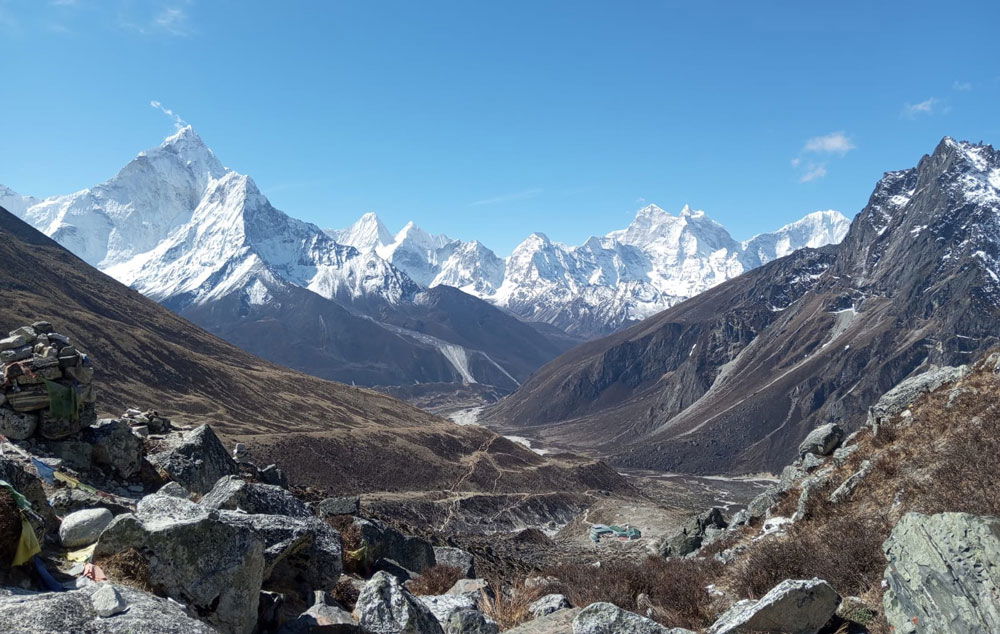Kathmandu to Everest Base Camp: How far from Kathmandu to EBC
Trip Overview
Kathmandu to Everest Base Camp is more than just a distance. It is a spiritual and physical journey. You’ll start in Kathmandu (1,400 m) and fly to Lukla (2,860 m), the gateway to the Everest region. The distance from Kathmandu to Everest Base Camp (EBC) is approximately 203 kilometers (126 miles). The typical trekking route to EBC starts with a flight from Kathmandu to Lukla, which is about 138 kilometers (86 miles) by air. From Lukla, the trek to Everest Base Camp is approximately 65 kilometers (40 miles). The round trip distance from Lukla to Everest Base Camp to Lukla is around 130 kilometers (80 miles), usually taking about 12 days, including acclimatization days.
The epic journey from Kathmandu to Everest Base Camp is a trek that takes you from the bustling, vibrant streets of Nepal’s capital to the awe-inspiring, serene heights of the world’s highest peak.
The actual trekking distance from Lukla, where most expeditions begin after a thrilling flight to Lukla. Now, imagine walking from Lukla to Everest Base Camp, but instead of flat, even terrain, you’re navigating through the heart of the Himalayas. The path is a series of steep climbs and descents, winding through ancient rhododendron forests, crossing rickety suspension bridges over roaring rivers, and passing through quaint Sherpa settlements where the air is as thin as the smile lines on a wise old yak.
You’ll ascend from the lowly elevation of Kathmandu, nestled at about 2860 meters above sea level, to the dizzying heights of Everest Base Camp, standing tall at 5,364 meters. That’s a vertical gain of over 1500 meters.
The sights you’ll see along the way, the towering peaks of the Khumbu region, including Lhotse, Nuptse, and the mighty Everest itself, will be your constant companions. You’ll trek through the fabled Khumbu Valley, where the air is crisp and the scenery is so breathtaking it feels like a painting that’s come to life. You’ll visit Namche Bazaar, the bustling gateway to the high Himalayas, and the sacred Tengboche Monastery, where the air is thick with the scent of incense and prayers.
You’ll cross the famous Khumbu Glacier and ascend the infamous Kala Patthar, a rocky knoll that offers a heart-stopping view of Everest. When you finally reach Base Camp, you’ll be greeted by the colorful tents of climbers from around the globe, all united in their quest to conquer the highest point on Earth.
So, while the distance might seem doable in the grand scheme of things, remember that this is no ordinary trip. It’s an exploration for the adventurous soul, a journey that tests your limits and rewards you with sights and experiences that are nothing short of life-changing. Whether you’re an experienced trekker or a novice looking for the challenge of a lifetime, the trek to Everest Base Camp is a distance that measures more than just kilometers – it’s a distance of the heart and spirit that you’ll carry with you long after your feet have left the trail.
Why Everest Base Camp Trek is so popular?
Ever wonder why thousands undertake this strenuous journey every year?
Mount Everest is not just the world’s tallest mountain. It is a global icon. The trek offers unmatched views of Everest, Lhotse, Ama Dablam, and other Himalayan giants. Add in Sherpa culture, friendly locals, and iconic spots like Namche Bazaar and Tengboche Monastery, and you’ve got the adventure of a lifetime.
It’s like walking into a National Geographic documentary but better, because you’re in it.
Best Time to go Everest Base Camp Trek
Choosing the right time to trek is crucial.
Best Seasons:
Spring (March to May): Clear skies, blooming rhododendrons, moderate temperatures.
Autumn (September to November): Crystal-clear views, stable weather, festive atmosphere.
Other Seasons:
Monsoon (June–August): Rain Fall, flight might delays due to cloudy weather
Winter (December–February): Extremely cold, heavy snow in higher altitudes.
How to Get from Kathmandu to Lukla
Lukla Airport is the standard starting point for the trek.
Options:
Flight from Kathmandu to Lukla (35 mins)
Drive to Ramechhap and Flight to Lukla (April–Nov): Due to air traffic at Kathmandu, flights are rerouted via Ramechhap.
Kathmandu to Everest Base Camp Trek Itinerary
| Day 01: Flight to Tenzing and Hillary Airport in Lukla (2804m/9199ft). Trek from Lukla to Phakding (Alt. 2610m/8563ft). Walking 4 hours. O/n in Mountain Lodge. |
| Day 02: Trek from Phakding to Namche Bazaar (Alt. 3441m/11289ft). Walking 6 – 7 hours. O/n in Mountain Lodge. |
| Day 03: Acclimatization day. Day trip to Shyangboche and Khumjung Village (Alt. 3780m/12402ft) and back to Namche Bazaar. Walking 5 hours. O/n in Mountain Lodge. |
| Day 04: Trek from Namche Bazaar to Tengboche (Alt. 3860m/12664ft). Walking 5 to 6 hours. O/n in Mountain Lodge. |
| Day 05: Trek from Tengboche to Dingboche (Alt. 4350m/14272ft). Walking 5 to 6 hours. O/n in Mountain Lodge. |
| Day 06: Acclimatization day. Walk around Dingboche. Walking 4 hours. O/n in Mountain Lodge. |
| Day 07: Trek from Dingboche to Lobuche (Alt. 4910m/4910ft). Walking 5 to 6 hours. O/n in Mountain Lodge. |
| Day 08: Trek from Lobuche to Everest Base Camp (Alt. 5365m/17602ft) then back to Gorak Shep. Walking 6 to 7 hours. O/n in Mountain Lodge. |
| Day 09: Hike up to Kalapatthar (Alt. 5555m/18225ft) then trek down to Pheriche (4200m/13780ft). Walking 7 hours. O/n in Mountain Lodge. |
| Day 10: Trek from Pheriche to Namche Bazaar (Alt. 3441m/11289ft). Walking 7 hours. O/n in Mountain Lodge. |
| Day 11: Trek from Namche Bazaar to Lukla (Alt.2804m/9199ft). Walking 7 hours. O/n in Mountain Lodge. |
| Day 12: Flight from Lukla and back to Kathmandu. |
Physical Preparation and Training
No need to be an Olympic athlete but basic fitness helps a lot.
Training Tips:
- Hiking practice with a backpack
- Cardio: Running, swimming, cycling
- Strength training: Focus on legs and core
- Stair climbing or incline treadmill walks
Prepare your body and mind, the trek is moderate to challenging but totally doable with preparation.
Necessary Permits
You’ll need a few documents to trek:
Permits Required:
Sagarmatha National Park Entry Permit
Khumbu Pasang Lhamu Rural Municipality Permit
Excellent Himalaya Trek and Expedition arrange all permits and logistic support for you.
What to Pack: Essentials Checklist
Think light, think smart. Here’s your packing cheat sheet:
Clothing:
Thermal base layers
Fleece jacket
Down jacket
Waterproof outer layers
Trekking pants
Gloves, beanie, and buff
Gear:
Sleeping bag (rated -10°C)
Trekking poles
Headlamp
Sunglasses
Water bottle & purification tablets
Other Must-Have:
Sunscreen, lip balm
Wet wipes
First-aid kit
Power bank
Remember, Lukla flights have a 15 kg limit, including hand luggage.
Culture and Etiquette in the Everest Region
Respect the locals, and they’ll welcome you like family.
Dos:
Greet with “Namaste”
Walk clockwise around stupas and prayer wheels
Ask before taking photos
Don’ts:
Don’t point your feet at religious objects
Avoid public displays of affection
Don’t give sweets to children (causes dental issues)
Cultural sensitivity enriches your experience.
Final Tips for a Safe and Memorable Trek
Get Travel Insurance covering high-altitude trekking.
Leave no trace: Pack out trash.
Carry some local cash: ATMs are only in Kathmandu and Namche.
Start early each day for the best weather.
Stay positive: The views are worth every step.
Trekking from Kathmandu to Everest Base Camp is like writing your own Himalayan epic. It might be tough, rewarding, and utterly unforgettable.
Excellent Himalaya Trek and Expedition is the leading local company and operator for Everest Base Camp Trek. Please contact us by email at [email protected] or WhatsApp at +977 9851203181 for any further information about the Everest Base Camp Trek. Once we get your message, we will get back to you with details within 24 hours.
Conclusion
The Kathmandu to Everest Base Camp trek is more than a hike. It is a transformative journey. With each step, you’re not just moving closer to the highest point on Earth; you’re pushing personal limits, embracing new cultures, and witnessing nature’s grandeur. Plan well, trek responsibly, and you’ll come home not just with photos, but with stories that last a lifetime.
Frequently Asked Questions (FAQs)
1. How long does the trek from Kathmandu to Everest Base Camp take?
Typically, the round trip takes about 12 to 14 days, including acclimatization days.
2. Is it possible to trek to Everest Base Camp without a guide?
Yes, it’s possible. However, hiring a guide is highly recommended for safety and navigation.
3. What is the cost of the Everest Base Camp trek?
Costs vary but average around $1,275, including permits, domestic flights, food, and lodging.
4. How cold does it get at Everest Base Camp?
Temperatures at EBC can drop to -10°C to -20°C, especially at night.
5. Can beginners do the Everest Base Camp trek?
Absolutely! With good preparation, acclimatization, and determination, even first-time trekkers can complete the journey.






